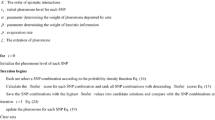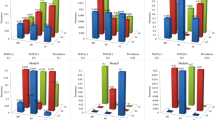Abstract
Epistasis has been receiving increasing attention in understanding the mechanism underlying susceptibility to complex diseases. Though many works have been done for epistasis detection, genome-wide association study remains a challenging task: it makes the search space excessively huge while solution quality is excessively demanded. In this study, we introduce an ant colony optimization based algorithm, AntMiner, by incorporating heuristic information into ant-decision rules. The heuristic information is used to direct ants in the search process for improving computational efficiency and solution accuracy. During iterations, chi-squared test is conducted to measure the association between an interaction and the phenotype. At the completion of the iteration process, statistically significant epistatic interactions are ordered and then screened by a post-procedure. Experiments of AntMiner and its comparison with existing algorithms epiMODE, TEAM and AntEpiSeeker are performed on both simulation data sets and real age-related macular degeneration data set, under the criteria of detection power and sensitivity. Results demonstrate that AntMiner is promising for epistasis detection. In terms of detection power, AntMiner performs best among all the other algorithms on all cases regardless of epistasis models and single nucleotide polymorphism size; compared with AntEpiSeeker, AntMiner can obtain better detection power but with less ants and iterations. In terms of sensitivity, AntMiner is better than AntEpiSeeker in detecting epistasis models displaying marginal effects but it has moderate sensitivity on epistasis models displaying no marginal effects. The study may provide clues on heuristics for further epistasis detection. The software package is available online at https://sourceforge.net/projects/antminer/files/.
Similar content being viewed by others
References
Balding DJ (2006) A tutorial on statistical methods for population association studies. Nat. Rev. Genet. 7: 781–791.
Cardon LR and Bell JI (2001) Association study designs for complex diseases. Nat. Rev. Genet. 2: 91–99.
Christmas J, Keedwell E and Frayling TM (2010) Ant colony optimisation to identify genetic variant association with type 2 diabetes. Inform. Sciences 181: 1609–1622.
Culverhouse R, Klein T and Shannon W (2004) Detecting epistatic interactions contributing to quantitative traits. Genet. Epidemiol. 27: 141–152.
Das S, Abraham A and Konar A (2008) Swarm intelligence algorithms in bioinformatics. Stud. Comp. Intell. 94: 113–147.
Fontanarosa J and Dai Y (2010) A block-based evolutionary optimization strategy to investigate gene-gene interactions in genetic association studies. IEEE Internat. Confer. Bioinform. Biomed. Workshop: 330–335.
Frankel WN and Schork NJ (1996) Who’s afraid of epistasis? Nat. Genet. 14: 371–373.
Gilmore J, Greene C, Andrews P, Kiralis J and Moore J (2011) An Analysis of New Expert Knowledge Scaling Methods for Biologically Inspired Computing. Lect. Notes Comput. Sci. 5778: 286–293.
Greene C, Gilmore J, Kiralis J, Andrews P and Moore J (2009a) Optimal use of expert knowledge in ant colony optimization for the analysis of epistasis in human disease. Lect. Notes Comput. Sci. 5483: 92–103.
Greene CS, Penrod NM, Kiralis J and Moore JH (2009b) Spatially uniform relieff (SURF) for computationally-efficient filtering of gene-gene interactions. BioData Min. 2: 5.
Greene CS, White BC and Moore JH (2008) Ant Colony Optimization for Genome-Wide Genetic Analysis. Lect Notes Comput. Sci. 5217: 37–47.
Jiang R, Tang W, Wu X and Fu W (2009) A random forest approach to the detection of epistatic interactions in case-control studies. BMC Bioinformatics 10Suppl 1: S65.
Klein RJ, Zeiss C, Chew EY, Tsai JY, Sackler RS, Haynes C, Henning AK, SanGiovanni JP, Mane SM, Mayne ST et al. (2005) Complement factor H polymorphism in age-related macular degeneration. Science 308: 385–389.
Li W and Reich J (2000) A complete enumeration and classification of two-locus disease models. Hum. Hered. 50: 334–349.
Maher B (2008) Personal genomes: The case of the missing heritability. Nature 456: 18–21.
Moore JH, Asselbergs FW and Williams SM (2010) Bioinformatics challenges for genome-wide association studies. Bioinformatics 26: 445–455.
Quevedo J, Bahamonde A, Prez-Enciso M and Luaces O (2011) Disease liability prediction from large scale genotyping data using classifiers with a reject option. IEEE/ACM T. Comput. Bi. 9: 88–97.
Rekaya R and Robbins K (2009) Ant colony algorithm for analysis of gene interaction in high-dimensional association data. Rev. Bras. Zootecn. 38: 93–97.
Risch N and Merikangas K (1996) The future of genetic studies of complex human diseases. Science 273: 1516–1517.
Ritchie MD, Hahn LW, Roodi N, Bailey LR, Dupont WD, Parl FF and Moore JH (2001) Multifactor-dimensionality reduction reveals high-order interactions among estrogen-metabolism genes in sporadic breast cancer. Am. J. Hum. Genet. 69: 138–147.
Shang J, Zhang J, Sun Y, Liu D, Ye D and Yin Y (2011) Performance analysis of novel methods for detecting epistasis. BMC Bioinformatics 12: 475.
Shen Y, Liu Z and Ott J (2010) Systematic removal of outliers to reduce heterogeneity in case-control association studies. Hum. Hered. 70: 227–231.
Tang W, Wu X, Jiang R and Li Y (2009) Epistatic module detection for case-control studies: a Bayesian model with a Gibbs sampling strategy. PLoS Genet. 5: e1000464.
Wan X, Yang C, Yang Q, Xue H, Tang NL and Yu W (2010) Detecting two-locus associations allowing for interactions in genome-wide association studies. Bioinformatics 26: 2517–2525.
Wang Y (2010) Computation Bioinformatics and Bioimaging Laboratory. http://www.cbil.ece.vt.edu/software.htm.
Wang Y, Liu X, Robbins K and Rekaya R (2010) AntEpiSeeker: detecting epistatic interactions for case-control studies using a two-stage ant colony optimization algorithm. BMC Res. Notes 3: 117.
Wei B, Peng Q, Zhang Q and Li C (2011) Identification of a combination of SNPs associated with Graves’ disease using swarm intelligence. Sci. China Life Sci. 54: 139–145.
WTCCC (2007) Genome-wide association study of 14,000 cases of seven common diseases and 3,000 shared controls. Nature 447: 661–678.
Yuan X, Zhang J and Wang Y (2011) Mutual information and linkage disequilibrium based SNP association study by grouping case-control. Genes Genom. 33: 65–73.
Zhang X, Huang S, Zou F and Wang W (2010) TEAM: efficient two-locus epistasis tests in human genome-wide association study. Bioinformatics 26: 217–227.
Zhang Y and Liu JS (2007) Bayesian inference of epistatic interactions in case-control studies. Nat. Genet. 39: 1167–1173.
Author information
Authors and Affiliations
Corresponding authors
Electronic supplementary material
Rights and permissions
About this article
Cite this article
Shang, J., Zhang, J., Lei, X. et al. Incorporating heuristic information into ant colony optimization for epistasis detection. Genes Genom 34, 321–327 (2012). https://doi.org/10.1007/s13258-012-0003-2
Received:
Accepted:
Published:
Issue Date:
DOI: https://doi.org/10.1007/s13258-012-0003-2




